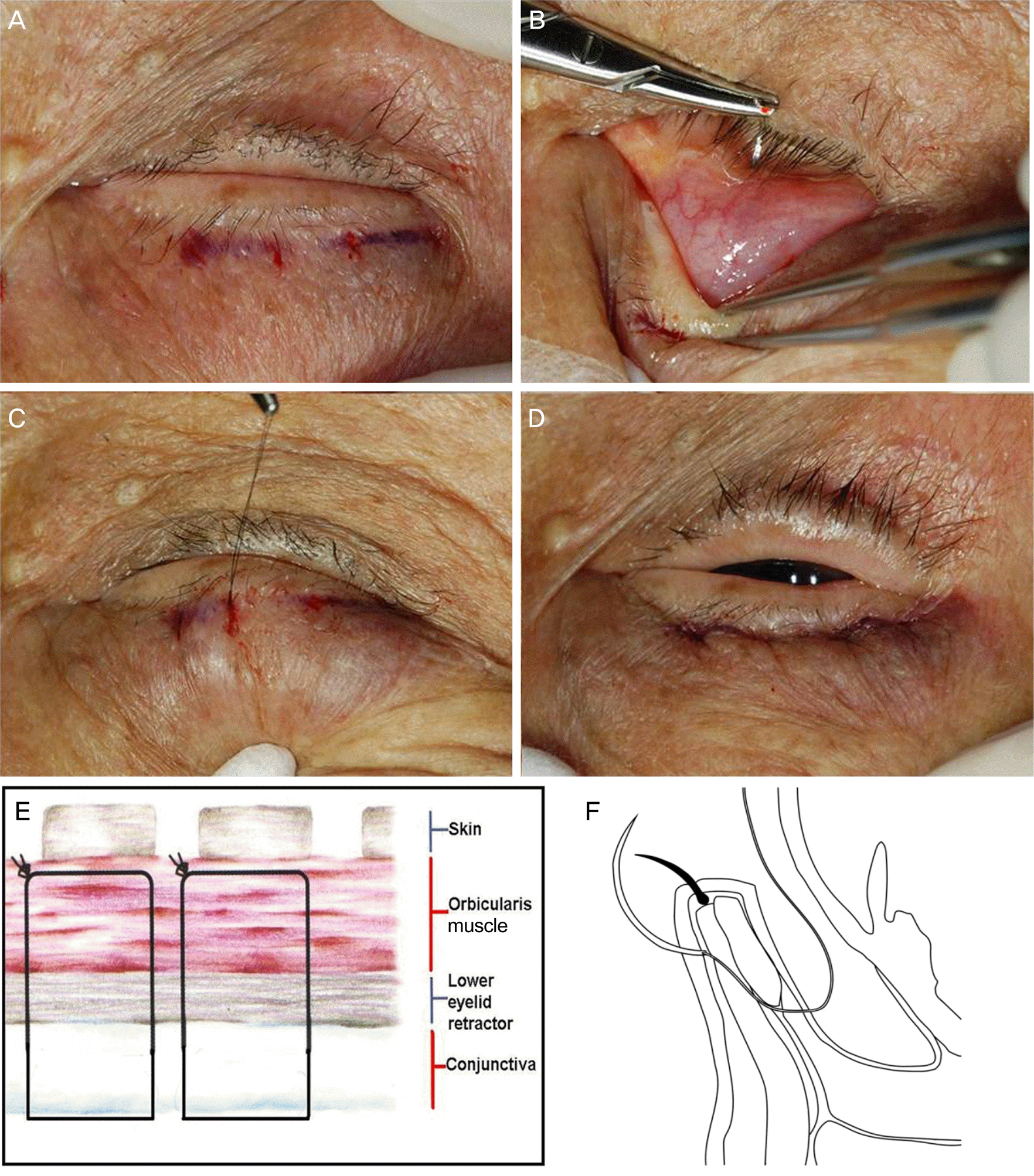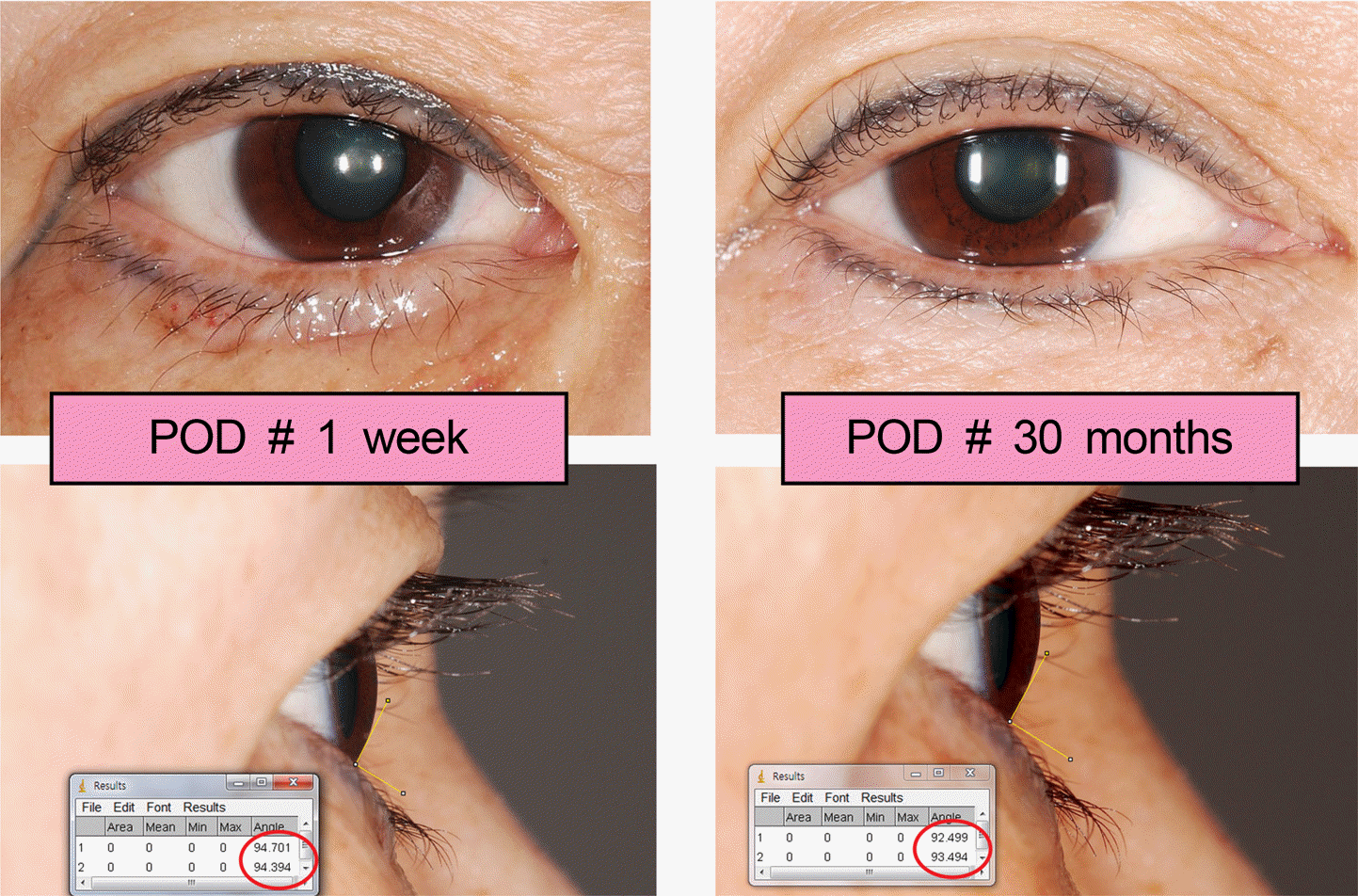Abstract
Purpose
To introduce and evaluate the long-term effectiveness of interrupted buried suture using non-absorbable material in involutional lower lid entropion.
Methods
A total of 105 adult involutional lower lid entropion patients (135 eyes) from January 2010 to January 2015 with or without the horizontal laxity, and without a history of previous surgical treatment were included. Exclusion criteria included patients with cicatricial entropion, epiblepharon, history of previous lower lid surgery, and follow-up period less than 3 months. The central and lateral areas below the lower lid margin and below the inferior tarsal margin were connected by non-absorbable interrupted buried suture. Results were analyzed by objective outcome using measurements from clinical photographs, subjective outcome using improvements of patients' symptom and cosmetic satisfactions.
Results
This study included 135 eyelids. Pre-operative distraction test revealed horizontal laxity in 37 eyes (27.4%). The mean age was 79.50 years and the mean period of follow-up was 34.51 ± 3.8 months. In 133 eyelids (98.5%), post-operative lid positions have everted. Score of symptom improvements were 9.44 (0 to 10 scale). 99 patients (94.3%) were cosmetically satisfied. No surgical complications were observed. Although we had two recurred cases (1.5%), one with horizontal laxity (2.7%) and one without horizontal laxity (1.0%), reoperation was not performed due to mild subjective discomfort.
Go to : 
References
1. Pereira MG, Rodrigues MA, Rodrigues SA. Eyelid entropion. Semin Ophthalmol. 2010; 25:52–8.
2. Marcet MM, Phelps PO, Lai JS. Involutional entropion: risk abdominals and surgical remedies. Curr Opin Ophthalmol. 2015; 26:416–21.
3. Ho SF, Pherwani A, Elsherbiny SM, Reuser T. Lateral tarsal strip and quickert sutures for lower eyelid entropion. Ophthal Plast Reconstr Surg. 2005; 21:345–8.

4. Baek JS, Choi SC, Jang SY, et al. Comparison of surgical outcome between quickert suture and quickert suture with modified lateral tarsal strip in involutional lower eyelid entropion. J Craniofac Surg. 2016; 27:198–200.

5. Meadows AE, Reck AC, Gaston H, Tyers AG. Everting sutures in involutional entropion. Orbit. 1999; 18:177–81.

6. Wright M, Bell D, Scott C, Leatherbarrow B. Everting suture abdominal of lower lid involutional entropion. Br J Ophthalmol. 1999; 83:1060–3.
7. Jang SY, Choi SR, Jang JW, et al. abdominal surgical outcomes of Quickert sutures for involutional lower eyelid entropion. J Craniomaxillofac Surg. 2014; 42:1629–31.
8. Ranno S, Sacchi M, Gilardi D, et al. Retractor plication versus abdominal plication and lateral tarsal strip for eyelid entropion correction. Eur J Ophthalmol. 2014; 24:141–6.
9. Yoon JM, Kim SA, Roh JH. Clinical results of different surgical abdominal in correcting involutional entropion. J Korean Ophthalmol Soc. 2008; 49:1877–87.
10. Baek JS, Ahn JH, Jang SY, et al. Comparison between continuous buried suture and interrupted buried suture methods for double eyelid blepharoplasty. J Craniofac Surg. 2015; 26:2174–6.

11. Ko YJ, Kim HC. Quickert suture using nonabsorbable suture abdominal for lower lid entropion. J Korean Ophthalmol Soc. 2014; 55:1739–44.
12. Damasceno RW, Osaki MH, Dantas PE, Belfort R Jr. Involutional entropion and ectropion of the lower eyelid: prevalence and abdominal risk factors in the elderly population. Ophthal Plast Reconstr Surg. 2011; 27:317–20.
13. Lanzl I, Merte RL, Poimenidou M. Botulinum toxin injections for senile entropium. Klin Monbl Augenheilkd. 2015; 232:37–9.
Go to : 
 | Figure 1.Photographs showing the distraction test. (A) A patient is looking straight before the distraction test. (B) The distraction test was performed to measure the distance from the globe to the pulled lid margin. |
 | Figure 2.Photograph of measuring eversion angles. Using the Image J program, the lower eyelid margin eversion was measured by the angle from the tangential line of the globe to the tangential line of the cilia root at the center of cornea for objective outcome. |
 | Figure 3.Photographs showing the surgical technique. (A) Central and temporal area of lower lid was demarcated. (B) Two dou-ble-armed sutures with non-absorbable 7–0 nylon were inserted from the conjunctival side 3–4 mm below the inferior tarsal border. (C) The ends of sutures were emerged through the skin side 3–4 mm below the lower lid margin. (D) The sutures were tied to yield slight overcorrection. (E) Schematic diagram of intermittent buried suture. (F) Schematic diagram of piercing from conjunctiva to eyelid. |
 | Figure 4.Clinical photograph of a patient who underwent bilateral lower eyelid interrupted buried suture. She had excellent objective outcomes at 1 week and at 30 months after surgery. The eversion was analyzed using Image J program. POD = postoperative day. |
Table 1.
Patient characteristics
Table 2.
Surgical outcomes




 PDF
PDF ePub
ePub Citation
Citation Print
Print


 XML Download
XML Download